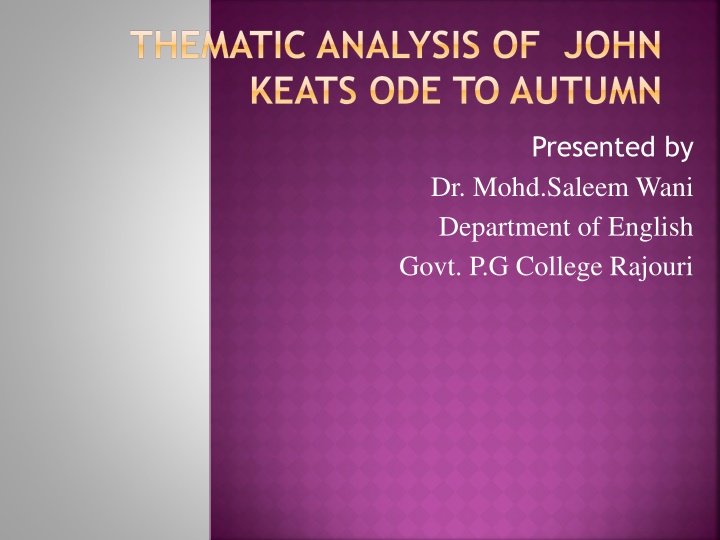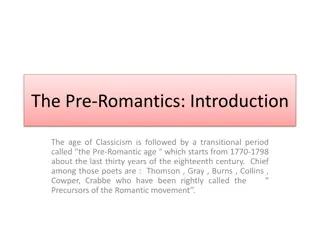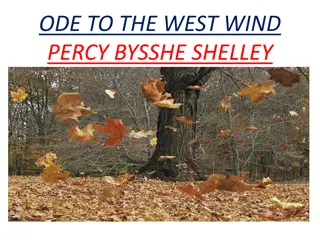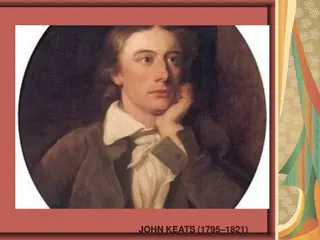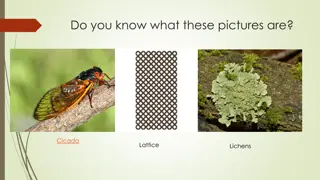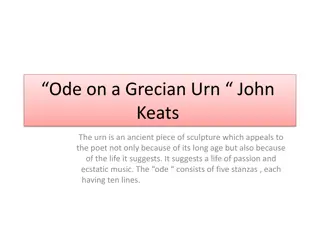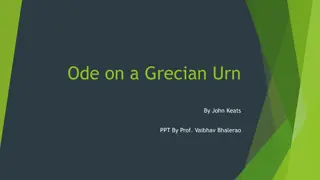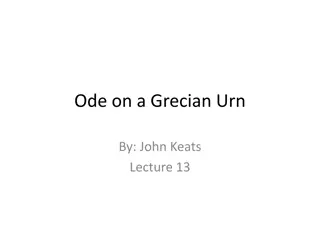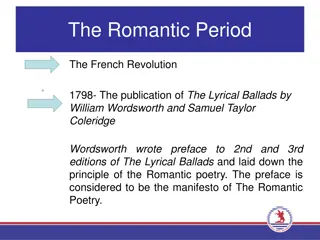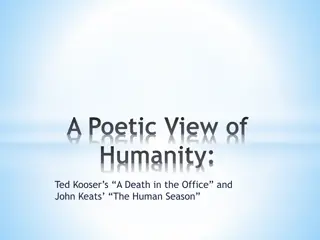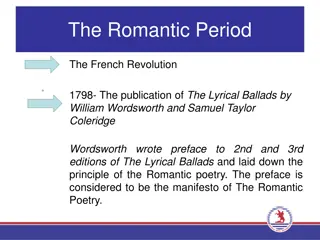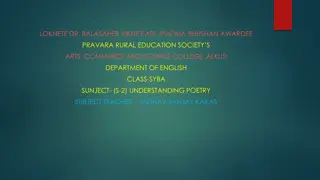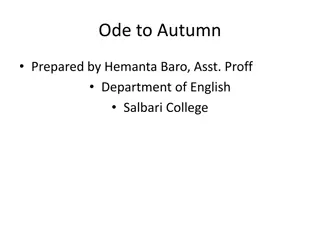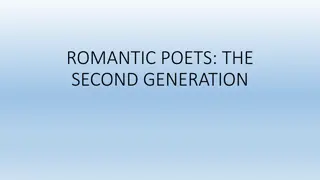Thematic Analysis of Keats' Ode to Autumn in the Context of Romantic Literature
The thematic analysis of John Keats' "Ode to Autumn" explores the poem's reflection on the beauty of seasonal transitions, emphasizing the melancholic yet serene nature of autumn. Presented by Dr. Mohd Saleem Wani, the analysis delves into Keats' ability to find beauty in the changing landscape and captures the essence of Romanticism through sentiment, imagination, and individualism.
Download Presentation

Please find below an Image/Link to download the presentation.
The content on the website is provided AS IS for your information and personal use only. It may not be sold, licensed, or shared on other websites without obtaining consent from the author.If you encounter any issues during the download, it is possible that the publisher has removed the file from their server.
You are allowed to download the files provided on this website for personal or commercial use, subject to the condition that they are used lawfully. All files are the property of their respective owners.
The content on the website is provided AS IS for your information and personal use only. It may not be sold, licensed, or shared on other websites without obtaining consent from the author.
E N D
Presentation Transcript
THEMATIC ANALYSIS OF JOHN KEATS ODE TO AUTUMN Presented by Dr. Mohd.Saleem Wani Department of English Govt. P.G College Rajouri
ROMANTICISM 18TH AND 19TH CENTURIES The Romantic Age : Romanticism was a movement in literature, art, and music that emphasized feeling over thought. In many ways it was a reaction to The Enlightenment, or at least it was a reaction against the philosophic notion that human actions were guided by the unchangeable forces of economics, sociology, and physics. Romanticism has very little to do with things popularly thought of as "romantic," although love may occasionally be the subject of Romantic art. Rather, it is an international artistic and philosophical movement that redefined the fundamental ways in which people in Western cultures thought about themselves and about their world.
ROMANTIC LITERATURE Romantic literature is dominated by poetry. The triumvirate of Keats, Shelley, and Byron are still well- known. The poetry of Keats is sentimental, that of Shelley intense, and Byron displays a mastery of sardonic wit. *Romanticism was an artistic and intellectual movement that originated in late 18th century Western Europe. It stressed strong emotion, imagination, freedom within or even from classical notions of form in art, and overturning of previous social conventions, particularly the position of the aristocracy. *The Romantics asserted the importance of the individual, the unique, even the eccentric. Also Romanticism is often understood as a set of new cultural and aesthetic values. It might be taken to include the rise of individualism.
INTRODUCTION * "To Autumn" is a poem for anyone who has a little trouble letting good things come to an end. It could be a relationship, a cherished experience, or just something you outgrow. And, of course, it could even be a favorite time of year. * Before writing this poem, John Keats surely knew that the rational thing to do would have been to write a poem in praise of spring, the season of life and rebirth. But despite their reputation for intense emotions, the British Romantic poets were not sentimentalists. They famously wrote odes in praise of things that most people wouldn't think to praise, like "Dejection" or "Melancholy." They found beauty in the neglected corners of life. In "To Autumn," Keats finds beauty in the lengthening days, chilly weather, and brown fields of fall, the time just before winter squelches the last bit of warmth and everyone retreats to their fires and hot cider. * Sadly, Keats was to become a living example of things coming to an end too soon. He died at the age of 25, only two years after completing this poem.
TEXT Season of mists and mellow fruitfulness! Close bosom-friend of the maturing sun; Conspiring with him how to load and bless With fruit the vines that round the thatch-eaves run; To bend with apples the mossed cottage-trees, And fill all fruit with ripeness to the core; To swell the gourd, and plump the hazel shells With a sweet kernel; to set budding more, And still more, later flowers for the bees, Until they think warm days will never cease, For Summer has o erbrimmed their clammy cells. Who hath not seen thee oft amid thy store? Sometimes whoever seeks abroad may find Thee sitting careless on a granary floor, Thy hair soft- lifted by the winnowing wind; Or on a half-reaped furrow sound asleep, Drowsed with the fume of poppies, while thy hook Spares the next swath and all its twined flowers; And sometimes like a gleaner thou dost keep Steady thy laden head across a brook; Or by a cider-press, with patient look, Thou watchest the last oozings, hours by hours. Where are the songs of Spring? Ay, where are the Think not of them, thou hast thy music too, - While barred clouds bloom the soft-dying day And touch the stubble-plains with rosy hue; Then in a wailful choir the small gnats mourn Among the river sallows, borne aloft, Or sinking as the light wind lives or dies; And full-grown lambs loud bleat from hilly bourn; Hedge- crickets sing, and now with treble soft The redbreast whistles from a garden-croft; And gathering swallows twitter in the skies.
THE ANALYSIS OF THE FIVE SENSES OF IMAGERY *Visual (Sight). * Aural, Auditory (Sound). * Smell, Olfactory. * Taste, Gustatory. * Sensation, Tactile (Touch).
MAN AND THE NATURAL WORLD "To Autumn" contains very specific natural landscapes and images. The first stanza offers images of the interaction between humans and the plants that surround them. The second describes the production of agriculture, a natural process that is controlled by people. The third stanza moves outside of the human perspective to include things that are not used or consumed by humans. This third section captures some of the "wildness" and unpredictability of nature.
TRANSFORMATION Autumn is the time of transformation between the growth of summer and the dormancy of winter. Things are winding down, and once the harvest is complete, there is nothing left to do but wait until the next season. Much of the transformation in the poem occurs between stanzas. For example, in the first stanza fruits and gourds are swelling outward before they will be picked for food. By the second stanza, the harvest is already complete, or mostly complete, and the ripe apples have been turned into rich, delicious cider. The third stanza focuses only on one transformative event, the setting of the sun.
MORTALITY Autumn is frequently used as a symbol in literature for old age, the time before death, symbolized by winter. "To Autumn" avoids any super-obvious references to death, but we do get some subtle ones, like the oblivious bees that think the summer will last forever, or the "hook" that spares the poppy flowers from their inevitable end. As the day begins to "die" in the final section, the entire landscape contributes to the song of mourning.
